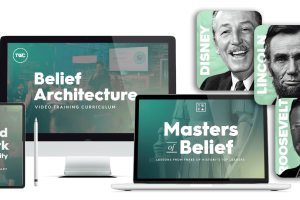Taylor Welch – Belief Architecture: The Complete Guide to Transforming Mindset, Identity & Performance
Introduction
Success in business, relationships, and personal development always comes back to one powerful concept: belief. Your beliefs shape your decisions, your habits, your identity, and ultimately, your outcomes. That is the core foundation behind Taylor Welch – Belief Architecture, a transformative framework built by one of the most respected entrepreneurs and mindset strategists of the modern era.
Taylor Welch is known globally for his ability to merge cognitive science, performance psychology, business mastery, and identity-based transformation into one cohesive system. Belief Architecture is not just another mindset program — it is a deep reconstruction of how you think, act, and interpret the world.
Whether you’re an entrepreneur seeking breakthroughs, a high performer looking to increase your capacity, or someone ready to rewrite inner stories that limit progress, the Belief Architecture framework can change the trajectory of your life.
This comprehensive, long-form guide will walk you through the philosophy, structure, and effectiveness behind Taylor Welch’s approach — and why it has become one of the most influential personal development systems available today.
1. Who Is Taylor Welch?
To understand the impact of Belief Architecture, you need to know the mind behind it.
Taylor Welch is:
-
A world-renowned performance strategist
-
A multi-eight-figure entrepreneur
-
Co-founder of Traffic & Funnels
-
Author, speaker, and trainer
-
Creator of global coaching companies
Taylor has mentored tens of thousands of entrepreneurs through strategic thinking, identity shifts, and structured performance systems. His work blends analytical insight with profound psychological depth.
The Taylor Welch – Belief Architecture framework reflects years of study in neuroscience, behavioral psychology, emotional mastery, narrative restructuring, and high-performance theory.
2. What Is Belief Architecture?
Belief Architecture is the process of breaking down, re-evaluating, and rebuilding the internal belief systems that control human performance.
It challenges the idea that mindset is simply “positive thinking.” Instead, Taylor focuses on identity-driven reprogramming, where lasting change comes from shifting the stories, self-definitions, and subconscious rules people operate under.
The framework teaches you how to:
-
Identify limiting beliefs
-
Rewire internal identity drivers
-
Strengthen emotional resilience
-
Upgrade internal narratives
-
Build high-performance habits
-
Install new self-concepts that support long-term success
This approach works because it addresses your root operating system, not just the symptoms.
3. Why Beliefs Matter More Than Strategy
Strategy is important — but strategy executed by a person with weak beliefs will always fail.
Taylor Welch argues that:
-
Belief precedes behavior
-
Identity precedes discipline
-
Thought patterns precede performance
-
Emotional patterns precede outcomes
If you do not shift the belief architecture of your identity, you will continue repeating cycles of self-sabotage, inconsistent habits, and emotional roadblocks.
Belief Architecture builds the mental infrastructure needed to support consistent achievement.
4. The Core Pillars of Taylor Welch – Belief Architecture
Taylor’s framework is built around several guiding principles:
a. Identity Reconstruction
You cannot outperform your current identity.
According to Taylor, real transformation happens when you upgrade who you believe you are at the subconscious level.
b. Narrative Engineering
Your internal stories — the silent scripts running in your mind — determine emotional responses and decision-making.
Taylor shows how to rewrite these stories for empowerment.
c. Emotional Calibration
Most performance breakdowns stem from emotional dysregulation.
Belief Architecture teaches emotional processing and resilience-building.
d. Cognitive Repatterning
Long-held beliefs become neural patterns.
This system helps you break old patterns and install new ones.
e. Future Identity Anchoring
Rather than setting goals, you learn to embody the version of yourself who naturally achieves them.
5. How the Belief Architecture Method Works
The framework follows a sequential process designed to guide you from awareness to identity-level transformation.
Step 1: Discover the Narrative
You begin by uncovering the hidden belief systems shaping your behavior — stories formed from childhood, culture, trauma, past failures, and environment.
Step 2: Decode the Emotional Triggers
Taylor shows how to analyze emotional reactions to reveal the underlying beliefs creating them.
Step 3: Dissolve Limiting Structures
Through structured exercises, you learn to break down old belief systems and detach emotionally from harmful narratives.
Step 4: Design the Upgraded Identity
You consciously build a new identity framework based on clarity, confidence, vision, and capability.
Step 5: Deploy the New Framework
Finally, you integrate new beliefs into your daily life through rituals, habits, language shifts, and progressive identity embodiment.
6. Why Belief Architecture Works So Well
There are several reasons why Taylor Welch’s method produces profound results:
1. It addresses the root cause — not the symptoms
Rather than trying to fix surface-level problems like procrastination or fear, it focuses on the identity layers beneath them.
2. It is based on psychology and neuroscience
The framework aligns with studies on neuroplasticity, emotional memory, and cognitive programming.
3. It uses repeatable, structured processes
There is clear methodology behind every step — making transformation measurable and trackable.
4. It aligns with real-world outcomes
High performers across industries use these principles to achieve consistent success.
7. What You Learn Inside the Belief Architecture Framework
Participants in Taylor Welch – Belief Architecture learn how to:
-
Break emotional loops
-
Shift from reactive to intentional behavior
-
Build new identity statements
-
Eliminate fear-based thinking
-
Create character-driven discipline
-
Strengthen internal confidence
-
Develop self-trust
-
Reset neurological patterns
-
Reframe failure and resistance
-
Upgrade self-image
-
Build mental fortitude
The teachings are deeply practical — not abstract or theoretical.
8. Who Is Belief Architecture For?
This framework is ideal for:
-
Entrepreneurs
-
High-performance professionals
-
Coaches
-
Leaders
-
Creators and innovators
-
Anyone feeling stuck, overwhelmed, or restricted by internal limits
If you struggle with inconsistency, procrastination, fear of visibility, emotional instability, or self-doubt, the system offers tools to break through.
9. Benefits of Applying Belief Architecture
People who integrate the Belief Architecture principles often experience:
-
Higher confidence
-
Reduced anxiety
-
Stronger decision-making
-
Improved performance
-
Clarity of purpose
-
Emotional stability
-
Better discipline
-
Stronger leadership presence
-
Long-term goal consistency
Because it focuses on identity, the changes are sustainable.
10. Why This Framework Is Gaining Global Recognition
The digital entrepreneurship world has saturated with tactics and strategies.
Yet most people fail because their beliefs sabotage them — not because their strategies are wrong.
Taylor’s approach stands out because:
-
It is deeply human
-
It is grounded in real psychology
-
It bridges internal growth with external success
-
It creates transformation instead of motivation
Belief Architecture is becoming a global movement because people crave identity-level change, not temporary inspiration.
Conclusion
The Taylor Welch – Belief Architecture framework is more than a mindset program — it is a full internal renovation system. It breaks down the old belief patterns that hold people back and replaces them with stronger identities, more empowered narratives, and deeply rooted emotional resilience.
Whether you’re aiming for business success, personal transformation, or long-term stability in your habits and thinking, this framework gives you the tools to reshape your identity from the inside out.
Belief Architecture is not about becoming someone new — it is about uncovering the strongest version of who you already are.






Reviews
There are no reviews yet.